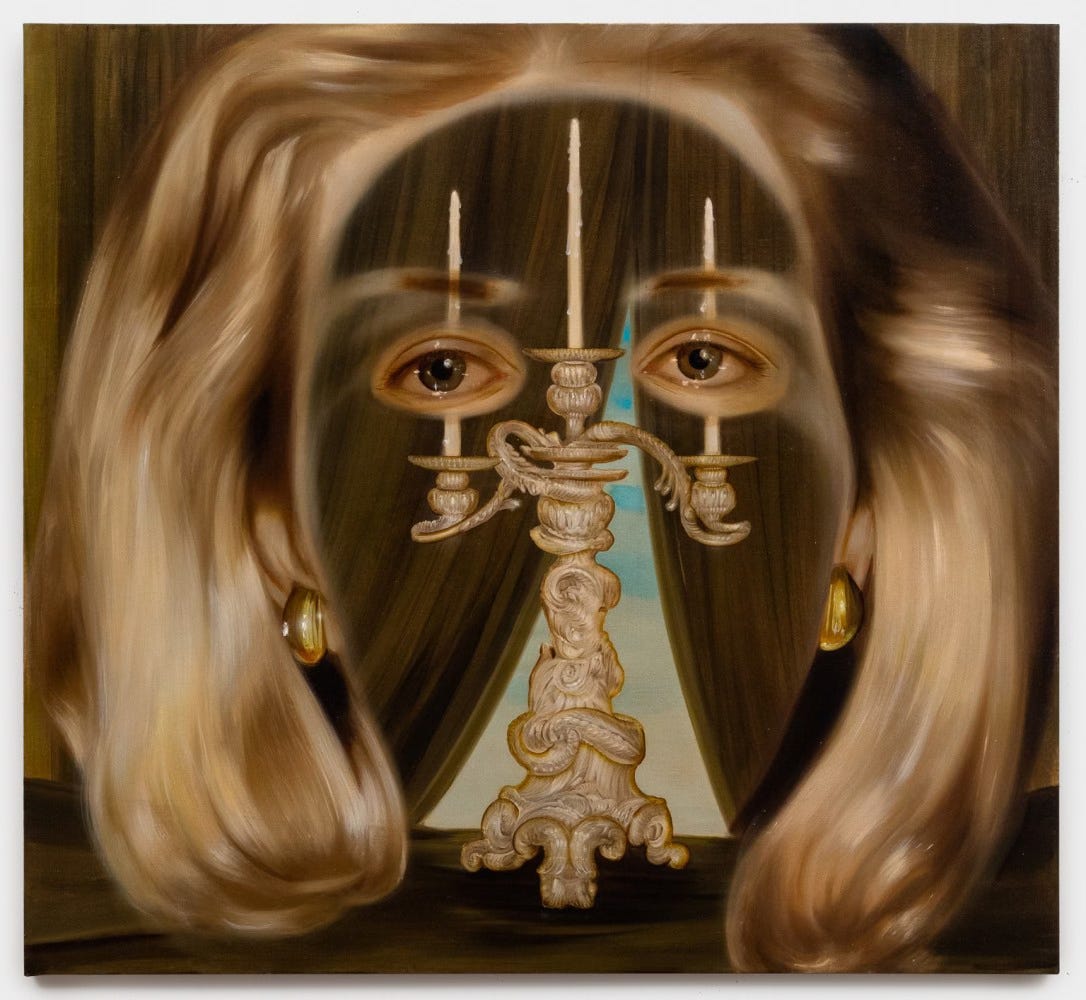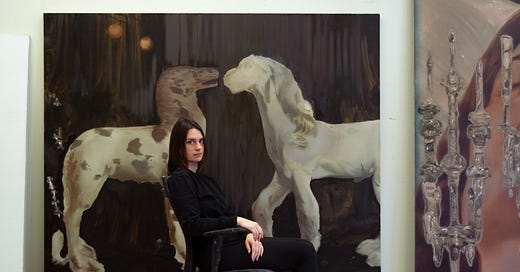Rae Klein
"I like to leave a little space to be filled in automatically by the viewer. Sometimes it’s just best to subtract things."
Rae Klein (b. 1995) lives and works in Michigan. She graduated from Eastern Michigan University in 2017 with a BFA. Exhibitions include DOUBLECROSS, Nicodim, Los Angeles (2025, solo); Echoes of Eden: A Return to Bosch's Garden, curated by Gaïa Jacquet-Matisse and Peter Brant Jr., Private residence, New York (2024); Niklas Asker, Rae Klein, Jorge Peris, Nicodim, New York (2024); The Ballad of the Children of the Czar, Galeria Nicodim, Bucharest (2024); DISEMBODIED, curated by Ben Lee Ritchie Handler, Nicodim, Los Angeles (2024); POWERPLAY, Nicodim, New York (2023, solo); Galeria Nicodim, Bucharest: 10 Years, Galeria Nicodim, Bucharest (2023); Last Night I Dreamt I Was Running, Galeria Nicodim, Bucharest (2023, solo); DISEMBODIED, curated by Ben Lee Ritchie Handler, Nicodim, New York (2023); LOW VOICE OUT LOUD, Nicodim, Los Angeles (2022, solo); The Comfort in Calamity, Jessica Silverman, San Francisco (2022, solo); BODYLAND, curated by Lauren Taschen, Galerie Max Hetzler, Berlin (2022).
MEPAINTSME: You currently live in Michigan and went to the state university. Are you originally from there?
RAE KLEIN: Yes! I’m from West Michigan but now I live in the southeast part of the state. I’ve lived in Michigan all my life.
MPM: After you graduated you circumvented the MFA track and created an audience for your work via Instagram. Graduate programs seem like a prerequisite these days to be looked at seriously by galleries. Were galleries hesitant to show you before you developed your Instagram following ?
RK: No, I’ve never had an issue with not having gone to grad school in regards to galleries. In the early days however, I wasn’t trying to get shows or anything, I was just enjoying making and sharing work. It never really come up as a negative thing when I began to get shows, either. I would never say an artist needs to go, or not go. I’m encouraged that there is no wrong path in this regard.

MPM: You didn’t study painting until your third year in undergrad and yet your technical proficiency in oils seemed present right out of the gate. When do you feel you began to master traditional oil painting?
RK: I think in the months after I graduated, when I was painting at my desk and doing lots of small, meticulous paintings. And then the year after that when I swung the opposite way and did all kinds of loose, oily paintings. I tried every material I was able to, and was able to narrow down to what works for me. I think the key is to do hundreds of paintings, and I have—and yet there are days when I feel like I don’t know how to paint.
MPM: In your current exhibition titled Doublecross at Nicodim, much of the work uses duplicate objects, like candelabras and handcuffs, superimposed on top of other images. Is the title of the show referring to this type of multiple imagery you use within a painting? What does the title mean?
RK: Yes, its about doubling as a sign of good and evil; being betrayed, or being afraid of the possibility. I also like compound words so it was a pretty good one.
MPM: I read that a lot of the objects you paint come from thrift stores and online. I’m an avid collector of antique books and magazines, myself, and draw a lot from the history they carry. Do you only use objects you find?
RK: With most of the things I paint, I relate to them as if they are words in a language. Dogs, windows, candelabras etc. I’m always shuffling through the pile for a new word. eBay, thrift stores, antique stores are great places for me to look. Used bookstores as well. These items have lost their context a bit, I think, and are easier for me to prescribe my own meaning to. I think you and I are both interested in collage. I can combo these ‘words’ up to form my paintings. I never buy the things, just use their images. However, some paintings, mostly of animals— I just paint those directly with no preparation.
MPM: Your paintings have always had this tension between presence and absence. Portraits are often just fragments of features or curtains floating in an empty space. Can you talk a bit about this dynamic in your work?
RK: I like to leave a little space to be filled in automatically by the viewer. Sometimes it’s just best to subtract things.
MPM: I notice many of the subjects you paint reflect light, which has spiritual connotations. Are you consciously trying to evoke some sort of divine presence by focusing on reflective objects?
RK: Hmm, very interesting, I haven’t thought about it much before but that does make a lot of sense.
MPM: In this show, you have some works that are quite loose and feel more improvisational. Is there one thing in particular that determines these different modes of working when you begin painting or do you like to just switch it up?
RK: Oh yes, these are definitely just painted without preparation, and are born very fast. They come when they feel like it! Usually when I am stumped on one of the other paintings.
MPM: Do you ever feel isolated from other artists where you live?
RK: No, I like working in this way, just going back and forth to the studio, and visiting the more active areas without thinking about working when I’m there.
MPM: What are some of the pros and cons of building a career and existing as an artist outside of major art markets like New York or L.A.?
RK: These are only personal to me. I think artists should be able to live wherever they want. Making art is kind of a weird and specific thing. What works for me is to be pretty isolated when I’m working, and not to be worried. Sort of like the thing where people wear the same outfit every day to eliminate that decision from their life. I have that here. I don’t have any aversion to moving though. I like each of the cities I’ve visited.
MPM: Thank you for taking the time to talk. Do you have any other projects that you’d like to mention beyond this exhibition?
RK: Not at the moment, just back to work!








Very authentic humble work.